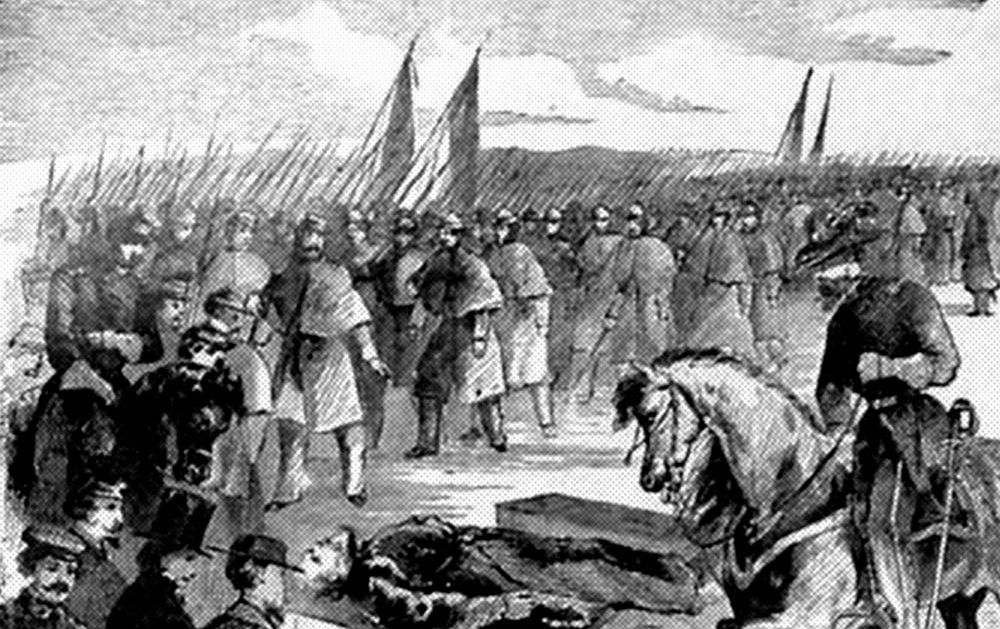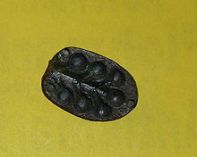


Apley and the Civil War
 Prince Rupert
Prince RupertWellington and Apley were to play an exciting role during the Civil War. It was Wellington market square that the King made the Wellington Declaration in 1642, that he should uphold the Protestant Religion, the Laws of England and the Liberty of Parliament. (This Declaration was considered so important that the Royal Mint issues new coinage in order to commemorate it).
The Charlton’s at Apley, like most of Shropshire, were strongly royalist and this - and differences within the family - were to make Apley Castle the scene of two bloody and destructive incidents.
Francis Charlton's widow, Mary, had remarried a royalist, Thomas Hanmer. (her brother in law, Robert Charlton, was seeking custody of her three young children by Francis Charlton in order to obtain Apley Castle and was, moreover, prominent in the Parliamentary Committee sitting at Wem). The Royalist Commander at Shrewsbury, Lord Capel, sent a garrison to defend Wellington from the Parliamentary forces. Apley Castle was ravaged to provide food and materials for the garrison and Hammer lost £4,000 worth of goods. He went to Shrewsbury to complain but was charged with high treason to the Commissioners of Prince Rupert and put in prison. "His case was after a time taken into consideration, and as it appeared that the house had been built by him at an expense of £6,000; the house was so disadvantageously situated, that if the enemy should become master of it, they might seriously molest the town of Shrewsbury, three propositions, embracing all evil alternatives to him, who wised to preserve it for the heir of the estate were offered to his acceptance at His Royal Highness Prince Rupert's quarters at Shrewsbury, the 7th day March, 1643."
In fact he was given the choice of "maintaining Apley as a fortress, leaving it to another to occupy or seeing the whole place blown up". Hanmer promised to defend Apley with is servants and tenants and was allowed to return there. He swore:-
"I Thomas Hanmer do by hereby declare that with his Highness good leave and approbation, I will man, defend, and maintain my house, or Castle of Apley against the rebel enyme, under the authority of this pretended Parliament at Westminster, at my own proper charges in defence of his Majesties' just cause. Thomas Hanmer. let this be accordingly. Signed Rupert.
Though Apley was described as "being a sort of a small castle" Robert Charlton knew it to be poorly defended and "procured it to be besieged by the Parliament soldiers, and stormed and taken, when the mother and children were there, and saw part of the building burnt and some lye dead before their eyes and all of them threatened and stripped of their clothing so that they were fian to borrow clothes and so Robert got possession of the Castle." This happened on March 18th, 1644.
Another account reads:- "The rebels drew out 500 horse and foot from Wem and Longford and put a garrison in Apley house; Col Mitton took Wellington church and Apley house having killed many and taken 28 prisoners and at Apley house... the rebels hastily thrust in garrison of both horse and foot with a good store of commanders from Wem staying there until ye garrison was well fortified." Mr Hanmer was made prisoner and £1,500 of his goods was taken as booty.
The Parliamentary forces did not hold apley for long. On March 24th 1644, The Royalists attacked the garrsion at Apley and retook the stronghold, taking many prisoners, horses, arms and ammunition.
(“On Sunday last, March 24 Col Roberts went to Apley House, plyed ye rebels so close with shot of all sorts, that in two howers he tooke ye House. Ye Col would not article with ye rebels, but having blocked it up with his Horse, he then led on his Musketeers, who followed him so well that the rebels at last cried Quarter, which he granted them. He took 10 commanders, … 73 other prisoners, 23 very good horses, with more arms and ammunition than to serve twice ye no., for ye rebels intended to enlarge ye garrisons as soon as they were able to send in more men.â€)
The Royalists killed 53 men, but permitted the prisoners to march away to Wem except for ten, who were kept for exchange.
The Royalists Commission of Array – thinking that Hanmer had not done enough to defend it – subsequently sequestered the Apley property, seized the remainder of the goods by the Parliamentarians, valued at £3,000 or £4,000, dismantled the house and carried away the lead valued at £2,600 to cover Shrewsbury Castle.
The damage caused to the Castle during the Civil War is uncertain, but an inventory of 1659 shows that the house was still large and habitable, with no less than 36 rooms. An inventory of 1663 also refers to a Brewhouse, Malthouse, Wash House, Granery and Stable.
With the loss of Apley, the Parliamentarians were forced to relinquish their other strongpoint in Wellington Church “for it was not possible to hold it with Apley gone†and retreated once more to Wem.
The parliamentarians were, of course to prevail and the English Civil War ended with the trial of Charles I and his subsequent execution by decapitation.
The heir to the “slighted†Apley Castle1, Francis Charlton, became a lawyer, spending much of his time in London. After the monarchy was restored he was invested with the Order of the royal Oak by Charles II for his family’s support during the Civil War, but Francis became a supporter of the Duke of Monmouth and became embroiled in the Rye house Plot, a conspiracy to assassinate Charles II and James, Duke of York. (he is also reported to have offered to fund a revolt in Scotland by raising £10,000 on mortgage, presumably on his estates at Apley). When this plot was uncovered, Francis Charlton – who became known as “one legged Charlton†having lost a leg at the age of 21 – was imprisoned in the tower of London, but subsequently released for lack of substantial evidence. Some of the other conspirators were less fortunate and were brutally executed.
He retired to his estate at Apley but continued to play an important role in the vents leading up to “the bloodless revolution†and the abdication of James II in 1698 and was buried in Wellington churchyard. (when the railway came many of the family memorials were disturbed. One effigy can, however, be seen in the Abbey at Shrewsbury and there are a number of Plaques in Wellington Church).

Friends of Apley Woods are now on Facebook.
You can now follow Friends of Apley Woods on Twitter





















